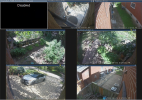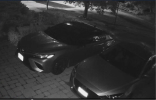Hello! I need recommendations for IP cameras. We purchased the house a couple years ago, and it came with 6 pre-wired cameras (see pic 1). The previous owner used a NRV which broke, so I hooked it up with a PC with Blue Iris. These cameras were likely Dahua from 10-20 years ago - they work, but the quality is not good, so I want to replace them with new cameras. I don't plan to change the locations of the cameras nor to add new ones, as the wiring is done already.
I don't know my needs! Obviously, I want more details, wider and clearer images for security reasons. But I'm not very sure what's possible. Below is what I can think off:
1. nigh vision: the current camera is terrible (see pic 2); do I need to install some outdoor lighting for this?
2. see license plates for incoming cars & any cars parked near my house in both day and night (from the FrontRight cam)
3. for the 2 backyard cameras, ideally I can see the critters eating any of my plants.
4. for FrontDoor and RightLane cameras, I want to see the faces of anyone approaching (RightLane covers two side doors).
I want to keep the budget under $2,000 CAD, if possible (for cameras only). I had purchased one EmpireTech-T24IR (before doing my research, not smart), and it was not installed yet. If needed, it can go too, but ideally it can be used somewhere.
My hard drive is 4TB, if it matters.
BTW, I am terrible at Blue Iris setup, so if anyone could throw tips or a guide, etc., that would be great. I don't use AI in BI and don't know how to set it up. Do I need it?
Thanks!


I don't know my needs! Obviously, I want more details, wider and clearer images for security reasons. But I'm not very sure what's possible. Below is what I can think off:
1. nigh vision: the current camera is terrible (see pic 2); do I need to install some outdoor lighting for this?
2. see license plates for incoming cars & any cars parked near my house in both day and night (from the FrontRight cam)
3. for the 2 backyard cameras, ideally I can see the critters eating any of my plants.
4. for FrontDoor and RightLane cameras, I want to see the faces of anyone approaching (RightLane covers two side doors).
I want to keep the budget under $2,000 CAD, if possible (for cameras only). I had purchased one EmpireTech-T24IR (before doing my research, not smart), and it was not installed yet. If needed, it can go too, but ideally it can be used somewhere.
My hard drive is 4TB, if it matters.
BTW, I am terrible at Blue Iris setup, so if anyone could throw tips or a guide, etc., that would be great. I don't use AI in BI and don't know how to set it up. Do I need it?
Thanks!


Last edited:

